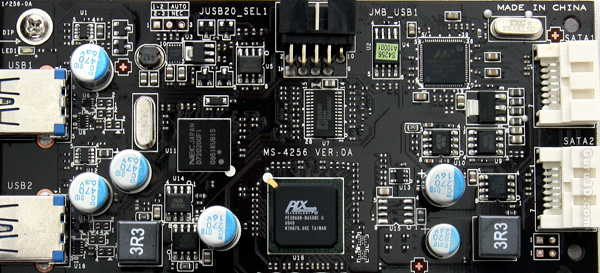Product gallery
Product gallery

So here's the kit we have available for testing. The MSI Star USB 3.0 add-on card, then another USB 3.0 card yet this time with embedded SATA6G controller as well and of course an all new SSD that ADATA submitted. This is the ADATA N002 which is a combo drive as it comes both with a SATA2 connector, and what we are after .. a USB 3.0 connector.

This is the Star USB3.0/SATA6 controller we'll be using for our test. The card comes with two external USB 3.0 ports and then another two through an internal header. The card has been occupied with both a NEC and Marvell chipset and is based on a PCI-E x4 Interface. Should you not have a PCIe 4x interface .. just drop it into a PCIe x16 slot, that should work fine just as well.

At the rear side we can see the two SATA 6G connectors. The black header in the middle is the extension connector which you need to lead to a USB header on your motherboard. This will feed the USB 3.0 ports with the proper power to feed say an SSD.

When we zoom in at the board we can see the chips and controllers used. To the left the NEC controller responsible for USB 3.0, to the upper right we see high-end Marvell 9128 controller for SATA III / 6G and in the lower middle a PLX chip pops out which functions as PCIe bridge chip.
The PLX8608 device offers 8 PCI Express Gen 2 (5.0 GT/s) lanes, capable of configuring up to 8 flexible ports. The switch conforms to the PCI Express Base Specification, rev 2.0. This allows the Marvell 9123 to connect to the PLX chip which on it's end then connects to the P55/X58 chipset via x4 lanes of PCIe 1.0 that provide as 1 GB/s of bandwidth.

Here a photo from our mockup system with this PCie 4x card seated into a 16x slot on a MSI X58 Eclipse motherboard. Luckily for MSI all their high-end motherboards are colored blue.
